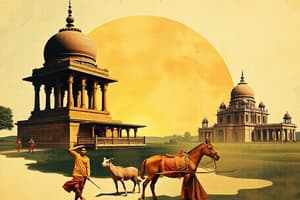Podcast
Questions and Answers
What is the primary feeling expressed by Doll I and Doll II regarding the child?
What is the primary feeling expressed by Doll I and Doll II regarding the child?
- Concern for the child's well-being
- Excitement about the future
- A sense of pride in creation
- Disgust and envy towards the child (correct)
What theme is most prominently highlighted by Padmini's attitude towards her childhood experiences?
What theme is most prominently highlighted by Padmini's attitude towards her childhood experiences?
- The importance of tradition over personal choice
- The inevitability of parental responsibilities
- The rejection of societal expectations in favor of freedom
- The strength that comes from childhood challenges (correct)
Which symbol appears to represent transformation and the passage of time?
Which symbol appears to represent transformation and the passage of time?
- The lake mentioned by Padmini
- The dolls' physical state
- The child's development
- The cobwebs around Doll I (correct)
What narrative technique is most evident through the dialogue between Padmini and Devadatta?
What narrative technique is most evident through the dialogue between Padmini and Devadatta?
How does the concept of the goddess play a role in the interactions among the characters?
How does the concept of the goddess play a role in the interactions among the characters?
What does Kapila’s reaction to Padmini’s departure suggest about his emotional state?
What does Kapila’s reaction to Padmini’s departure suggest about his emotional state?
Which theme is highlighted through Padmini's statement about leaving with Devadatta's body?
Which theme is highlighted through Padmini's statement about leaving with Devadatta's body?
What symbolic meaning can be derived from the dolls Devadatta brings home?
What symbolic meaning can be derived from the dolls Devadatta brings home?
How does Kapila's questioning of his own identity contribute to the narrative?
How does Kapila's questioning of his own identity contribute to the narrative?
What role does the character of Devadatta play in relation to traditional gender expectations?
What role does the character of Devadatta play in relation to traditional gender expectations?
How does the setting of the fair contribute to the themes of transformation in the narrative?
How does the setting of the fair contribute to the themes of transformation in the narrative?
What narrative technique is prominently used when Kapila exits after pondering his identity?
What narrative technique is prominently used when Kapila exits after pondering his identity?
What does Padmini's act of stitching suggest about her character in the context of gender roles?
What does Padmini's act of stitching suggest about her character in the context of gender roles?
Which character expresses anxiety about physical appearance and strength?
Which character expresses anxiety about physical appearance and strength?
What is the primary emotion displayed by Devadatta when he is questioned about his gym visit?
What is the primary emotion displayed by Devadatta when he is questioned about his gym visit?
What does the appearance of the man in the dream symbolize in terms of Padmini's inner conflict?
What does the appearance of the man in the dream symbolize in terms of Padmini's inner conflict?
In the dialogue, who comments on the rough appearance of the man in Padmini's dream?
In the dialogue, who comments on the rough appearance of the man in Padmini's dream?
What thematic element is illustrated through Padmini's reflections on past relationships?
What thematic element is illustrated through Padmini's reflections on past relationships?
How does Devadatta's reaction to Padmini's concern reflect on their relationship dynamic?
How does Devadatta's reaction to Padmini's concern reflect on their relationship dynamic?
What emotion do DOLL I and DOLL II express as they observe Padmini's dream?
What emotion do DOLL I and DOLL II express as they observe Padmini's dream?
Which aspect of transformation is most evident in Padmini's character development?
Which aspect of transformation is most evident in Padmini's character development?
What does the fading image of the man in Padmini's dream represent?
What does the fading image of the man in Padmini's dream represent?
What literary technique is predominantly used in the dolls' conversation?
What literary technique is predominantly used in the dolls' conversation?
What transformation is noted about Devadatta's physical appearance by the dolls?
What transformation is noted about Devadatta's physical appearance by the dolls?
What does the lullaby sung by Padmini symbolize in the context of the narrative?
What does the lullaby sung by Padmini symbolize in the context of the narrative?
How does Devadatta's change in physical condition contribute to the theme of identity?
How does Devadatta's change in physical condition contribute to the theme of identity?
What role do the dolls play in the narrative?
What role do the dolls play in the narrative?
What does the imagery in Padmini’s lullaby convey about the perceived hero?
What does the imagery in Padmini’s lullaby convey about the perceived hero?
Which aspect of Devadatta's transformation might symbolize his internal conflicts?
Which aspect of Devadatta's transformation might symbolize his internal conflicts?
What theme is highlighted through the contrast between the dolls' observation and Devadatta's actions?
What theme is highlighted through the contrast between the dolls' observation and Devadatta's actions?
How does the setting contribute to the theme of transformation in the narrative?
How does the setting contribute to the theme of transformation in the narrative?
What significance does the mention of 'jasmines' and 'pebbles' in Padmini's lullaby have?
What significance does the mention of 'jasmines' and 'pebbles' in Padmini's lullaby have?
What can be inferred about Padmini’s relationship with Devadatta based on their interactions?
What can be inferred about Padmini’s relationship with Devadatta based on their interactions?
Flashcards
Devadatta and Padmini's relationship
Devadatta and Padmini's relationship
Devadatta and Padmini are getting married, showcasing a joyful aspect of their lives.
Kapila's separation
Kapila's separation
Kapila leaves Dharm apura and enters the forest, potentially due to a separation or personal reasons.
Devadatta's gifts
Devadatta's gifts
Devadatta brings dolls from the Ujjain fair as gifts, intending them to be playmates for an expected guest.
Padmini's reaction to dolls
Padmini's reaction to dolls
Signup and view all the flashcards
Ujjain fair
Ujjain fair
Signup and view all the flashcards
Wrestler from Kamarupa
Wrestler from Kamarupa
Signup and view all the flashcards
Dharm apura
Dharm apura
Signup and view all the flashcards
Kapila's sadness
Kapila's sadness
Signup and view all the flashcards
Devadatta's Moaning
Devadatta's Moaning
Signup and view all the flashcards
Devadatta's Gym Visit
Devadatta's Gym Visit
Signup and view all the flashcards
Padmini's Fear
Padmini's Fear
Signup and view all the flashcards
Kapila's Absence
Kapila's Absence
Signup and view all the flashcards
Kapila's Appearance
Kapila's Appearance
Signup and view all the flashcards
Dolls' Dream Interpretation
Dolls' Dream Interpretation
Signup and view all the flashcards
Dream Visitor
Dream Visitor
Signup and view all the flashcards
Fading Dream
Fading Dream
Signup and view all the flashcards
Daytime Dream
Daytime Dream
Signup and view all the flashcards
Intensified Dream
Intensified Dream
Signup and view all the flashcards
Padmini's view on bringing him to the lake
Padmini's view on bringing him to the lake
Signup and view all the flashcards
Devadatta's role and responsibilities
Devadatta's role and responsibilities
Signup and view all the flashcards
Padmini's frustration
Padmini's frustration
Signup and view all the flashcards
Devadatta's affection
Devadatta's affection
Signup and view all the flashcards
The dolls' perspective
The dolls' perspective
Signup and view all the flashcards
Devadatta's Transformation
Devadatta's Transformation
Signup and view all the flashcards
Dolls' Observation
Dolls' Observation
Signup and view all the flashcards
Padmini's Lullaby
Padmini's Lullaby
Signup and view all the flashcards
The White Rider
The White Rider
Signup and view all the flashcards
The Red Jasmine
The Red Jasmine
Signup and view all the flashcards
The Cold Body
The Cold Body
Signup and view all the flashcards
The White Horse Gallops
The White Horse Gallops
Signup and view all the flashcards
Padmini's Fear of Separation
Padmini's Fear of Separation
Signup and view all the flashcards
The Shifting Symbolism
The Shifting Symbolism
Signup and view all the flashcards
Study Notes
Act Two Summary
- The play's second act opens with a question about how to solve a problem that affects three beings.
- Historical context is provided with King Vikrama's encounter with a demon.
- The play's characters are seeking a solution through a rishi.
- The play uses a song to convey the solution.
- The characters scream with delight and dance after a decision is made regarding the rightful husband of a woman.
- The play's characters have funny and emotional interactions including jokes.
- The play has a variety of characters who are involved in conflicts and discussions.
- The play has significant use of characters using props like dolls.
- There are instances of conversations involving worries over the dolls, and worries regarding the future.
- There are several conflicts among characters, particularly in terms of decisions and actions towards one another.
Key Characters
- King Vikrama
- Demon Vetala
- Devadatta
- Padmini
- Kapila
Key Concepts
- Problem-solving
- Historical events
- Divine intervention or guidance
- Character relationships
- Emotional expression
Studying That Suits You
Use AI to generate personalized quizzes and flashcards to suit your learning preferences.
Related Documents
Description
Dive into the intriguing events of Act Two of the play featuring King Vikrama. This act unfolds the quest for solutions involving conflict resolution, lively character interactions, and the use of props like dolls. Explore the dynamics between the characters as they seek guidance from a rishi amid delightful songs and emotional exchanges.




